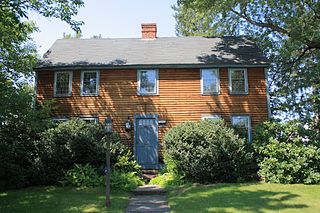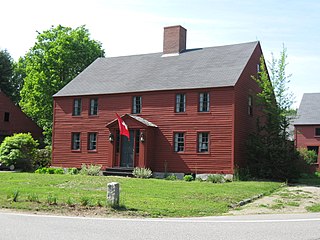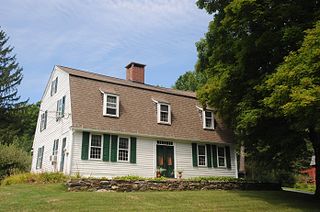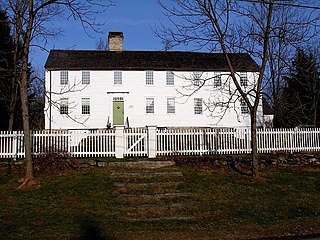
The Colonel John Ashley House is a historic house museum at 117 Cooper Hill Road in Sheffield, Massachusetts. Built in 1735 by a prominent local leader, it is one of the oldest houses in southern Berkshire County. The museum is owned and operated by The Trustees of Reservations, and is listed on the National Register of Historic Places.

The Dr. Elizur Hale House is a historic house at 3181 Hebron Avenue in Glastonbury, Connecticut. Built about 1780, it is a prominent local example of well-preserved late Georgian domestic architecture. It is also notable for its association with the locally prominent Hale family, who occupied it for 100 years. The house was listed in the National Register of Historic Places in 1989.

The Daniel Morse III House is a historic First Period house at 210 Farm Road in Sherborn, Massachusetts. With its oldest portion dating to about 1710, it is one of the town's oldest surviving buildings. It was listed on the National Register of Historic Places in 1986.

The Acadian House is a historic house on Union Street in Guilford, Connecticut. Built about 1670, it is one of Connecticut's oldest surviving houses, notable for its occupation by refugee Acadians following their 1755 deportation from Nova Scotia. The house was listed on the National Register of Historic Places in 1975.

The John Tyler House is a historic house at 242–250 East Main Street in Branford, Connecticut. Built about 1710, it is one of the town's few surviving 18th-century residences, and good example of late First Period architecture. The house was listed on the National Register of Historic Places in 1988.

The Timothy Goodman House is a historic house at 567 Quaker Lane South in West Hartford, Connecticut. Built in the early to mid-18th century, it is one of West Hartford's few surviving 18th-century houses. It was listed on the National Register of Historic Places on September 10, 1986.

The Whitman House is a historic house at 208 North Main Street in West Hartford, Connecticut. Built about 1764, it is one of the town's few surviving 18th-century buildings. It was listed on the National Register of Historic Places on September 10, 1986.

Brigham's Tavern is a historic house and traveller's accommodation at 12 Boston Turnpike in Coventry, Connecticut. With a construction history dating to the early 18th century, it is one of the town's oldest buildings, and is historically associated with George Washington, who stopped here for a meal in 1789. Now a private residence, it was listed on the National Register of Historic Places in 1982.

The James Hazelton House, also known as the Hazelton-Hayden House, is a historic house at 23 Hayden Hill Road in Haddam, Connecticut. With a construction history dating to about 1720, it is one of the town's oldest buildings, with a long history of ownership by a single prominent local family. The house was listed on the National Register of Historic Places in 1988, and is a contributing property in the Haddam Center Historic District.

The William Ward Jr. House is a historic house at 137 Powder Hill Road in Middlefield, Connecticut. Built in 1742, it is the oldest surviving house in Middlefield. It was listed on the National Register of Historic Places in 1988.

The Pelatiah Leete House is a historic house at 575 Leete's Island Road in Guilford, Connecticut, United States. Built in 1710 by Pelatiah Leete, it is the oldest surviving house associated with the locally prominent Leete family, who were among the founders of the New Haven Colony. The house was listed on the National Register of Historic Places in 1974.

The Burt–Cheney Farm is a historic farmstead on U.S. Route 302 in Bethlehem, New Hampshire. The main farm house, built in part about 1818, is a rare early Cape-style house, and is one of the oldest surviving buildings in the town. The property was listed on the National Register of Historic Places in 1982.

The Greeley House is a historic First Period house on New Hampshire Route 108, east of the center of East Kingston, New Hampshire. Built about 1718, it is one of the community's oldest surviving buildings, and a distinctive and visible reminder of its largely agrarian past. The house was listed on the National Register of Historic Places in 1980.

The Elijah Locke House is a historic house at 5 Grove Road in Rye, New Hampshire. Traditionally ascribed a construction date of 1739, it is one of the oldest surviving buildings in New Hampshire's Seacoast region. It was listed on the National Register of Historic Places in 1979.

The Stelljes House is a historic house on New Hampshire Route 31 in Goshen, New Hampshire. Built about 1800, it is one of the oldest of a cluster of plank-frame houses in Goshen. The house was listed on the National Register of Historic Places in 1985. It has possibly been demolished.

The Amos Baldwin House is a historic house at 92 Goshen Street East in Norfolk, Connecticut, United States. Built about 1765, it is an important surviving example of colonial architecture in the community, and is one of its oldest buildings with a gambrel roof. It was listed on the National Register of Historic Places in 2016.

The David Welch House is a historic house at Potash and Milton Streets in Milton village of Litchfield, Connecticut. Built in 1756 by one of the first colonial settlers of the area, it is one of the village's oldest buildings. It was listed on the National Register of Historic Places in 1984.

The Salmon Brook Historical Society is the local historical society of Granby, Connecticut. The society's museum property is located and 208 Salmon Brook Street, and includes four historic buildings, which include museum displays of historic items, and a small research library. Two of the buildings, the Rowe and Weed Houses, are listed as a pair on the National Register of Historic Places.

The Reuben Curtiss House is a historic house at 1770 Bucks Hill Road in Southbury, Connecticut. With a construction and alteration history dating from the late 18th to 20th centuries, the house is one of Southbury's finest examples of residential Greek Revival architecture. It was listed on the National Register of Historic Places in 1993.

The Shelley House is a historic house at 248 Boston Post Road in Madison, Connecticut. Probably built in the late 17th century and enlarged in the 18th century, this house's architecture clearly exhibits a typical growth pattern of colonial-era houses from a one-room stone ender to a saltbox house. The house was listed on the National Register of Historic Places in 1989.























